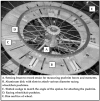SMARTWheel: From concept to clinical practice
- PMID: 19658010
- PMCID: PMC2739657
- DOI: 10.1080/03093640903082126
SMARTWheel: From concept to clinical practice
Abstract
Wheelchair prescription is complex with thousands of choices and options. Theoretically, a higher quality or innovative wheelchair that is appropriately matched to the user and their unique needs will increase participation. It is well accepted that there is an alarmingly high incidence of carpal tunnel syndrome, and rotator cuff injuries among manual wheelchair users. Since the initial conceptualization, the SMART(Wheel) was intended to better understand the physiological and physical effects of wheelchair propulsion on the body. Initially, little was known about wheelchair propulsion and the SMART(Wheel) transformed the nascent field of wheelchair propulsion biomechanics. Although still an important area of clinical research, the SMART(Wheel) has been critical to the study of the relationship between the type of wheelchair, set-up, activity, technique, anatomy, and physiology and repetitive strain injury. There has been growing evidence that the wheelchair-user interaction explains a substantial portion of the risk of developing a degenerative injury and on community participation. A noteworthy contribution of this work was the release of the clinical practice guideline, entitled, Preservation of Upper Limb Function Following Spinal Cord Injury in 2005. The SMART(Wheel) has been used by other scientists in areas that were not originally envisioned to be applications. It has been used to support the design of tools for developing a trail mapping rating and description system. It has also supported the design of accessible pedestrian walkways standards, accessible playground surfaces, and to evaluate carpets for wheelchair accessibility. It is likely that there are more new areas of exploration to emerge. This article describes the evolution of the SMART(Wheel) as new technologies became available and its applications in the field of wheelchair biomechanics and clinical service delivery.
Figures







References
-
- Asato KT, Cooper RA, Robertson RN, Ster JF. SMARTWheels: Development and Testing of a System for Measuring Manual Wheelchair Propulsion Dynamics. IEEE Transactions on Biomedical Engineering. 1993;40(12):1320–1324. - PubMed
-
- Boninger ML, Robertson RN, Wolff M, Cooper RA. Upper Limb Nerve Entrapments in Elite Wheelchair Racers. American Journal of Physical Medicine & Rehabilitation. 1996;75:170–176. - PubMed
-
- Boninger ML, Cooper RA, Robertson RN, Shimada SD. 3-D Pushrim Forces During Two Speeds of Wheelchair Propulsion. American Journal of Physical Medicine and Rehabilitation. 1997;76(5):420–426. - PubMed
-
- Boninger ML, Cooper RA, Baldwin MA, Shimada SD, Koontz A. Wheelchair Pushrim Kinetics: Weight and Median Nerve Function. Archives of Physical Medicine and Rehabilitation. 1999;80(8):910–915. - PubMed
-
- Boninger ML, Baldwin M, Cooper RA, Koontz AM, Chan L. Manual Wheelchair Pushrim Biomechanics and Axle Position. Archives of Physical Medicine and Rehabilitation. 2000;81(5):608–613. - PubMed
Publication types
MeSH terms
Grants and funding
LinkOut - more resources
Full Text Sources
Other Literature Sources
Medical

